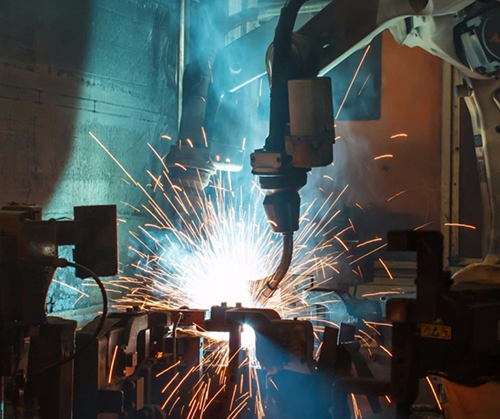
Robotics Leadership: Coming of Age in India
Can India Build a Homegrown, Indigenous Robot Industry to Rival China’s?
India has the highest number of manufacturers investing in technology. India's manufacturers are investing 35% of their budgets in technologies – much more than the global average of 23%
According to Mahesh Wagle of robotics firm, Cybernetik Technologies, “there were less than 100 robots made annually for industries in India about 15 years back”. He adds that there are 5,000 to 6,000 robots built every year now. Wagle says that India is “still around 5-6 years behind China in automation” – but is aspiring to automate and become a part of the global supply chain.
In his recent interview, Nikhil Ramaswamy of CynLr talks about the crucial role that robots have played in making China’s image as a global manufacturer. Traditionally, China is the largest buyer of robots accounting for nearly half of the industrial robot installations in 2021.
A PwC study found that 50% of CFOs want to accelerate automation across their organizations. As manufacturing enters the Industry 4.0 phase, robotic solution developers in India can enable manufacturers to adopt this technology.
Can India successfully rival China’s robot industry with its homegrown industry? Let’s talk about it.
Favorable Factors for India Against China
What are the current factors favoring India’s robot industry against that of China? Here are some of them:
1. The Emergence of Industry 4.0
A recent report on Industry 4.0 in India highlights that domestic manufacturing spent between $5.5 to $6.5 million on Industry 4.0 solutions in 2021. Manufacturers are trying to leverage the immense potential of Industry 4.0 to automate processes like material handling and workforce safety. In India, automotive companies like Bajaj Auto and Bharat Forge are deploying automation technologies to eliminate human errors and reduce human exposure to hazardous materials and environments.
2. The Demographic Shift in China
China’s “one-child policy” is creating demographic challenges by not adding to their working-age population. According to the latest reports, the country’s working-age population declined from 997 million (in 2014) to 986 million (in 2021). China-based Changying Precision Technology has constructed a “robots-only” factory – where robots comprise 90% of the workforce.
 Unlike China, India does not face a demographic crisis. According to Ernst & Young, India’s working-age population will increase to 68.9% of the total population by 2030. Despite the favorable demographics, young graduates in India are unable to meet the skill demand. Hence, more companies are likely to turn to robotics to complete their skilled work. For instance, Bangalore-based Flipkart is implementing robotics to improve the operational efficiency of its warehouses.
Unlike China, India does not face a demographic crisis. According to Ernst & Young, India’s working-age population will increase to 68.9% of the total population by 2030. Despite the favorable demographics, young graduates in India are unable to meet the skill demand. Hence, more companies are likely to turn to robotics to complete their skilled work. For instance, Bangalore-based Flipkart is implementing robotics to improve the operational efficiency of its warehouses.
3. Technology is Replacing Cheap Labor
Thanks to their growing population, both China and India have had the advantage of providing a large pool of cheap labor. Gradually, cheap labor is being replaced with technologies like robotics. With its “Make in India” initiative, India was able to compete head-to-head with China in manufacturing high-quality products at cheaper costs.
With the advent of Industry 4.0, India can look to build this advantage by building smart factories using technologies like Robotics and the Internet of Things.
4. Rise of the MSME Sector in India
Ministry of Micro, Small & Medium Enterprises
The Industry 4.0 report also noted the emergence of MSMEs in India. MSMEs now account for a third of India’s manufacturing output and 50% of its exports. Guruprasad Bangle of Solution Buggy says, “MSMEs are adopting Industry 4.0 solutions to survive”. Among the recent developments, automotive and pharma MSMEs are investing heavily in automation technologies like robotics.
According to Darshana Thakkar, collaborative robots (or cobots) are “boosting the Make in India initiative with their flexibility and faster ROI”.
What does India need to do more to gain a competitive edge over China in the coming years? Let’s discuss that next.
What India Needs to Do
Despite its market advantages, India needs to do a lot more to gain a competitive edge over China’s robotics industry. Here is a list of what India can do:
1. Long-term Investment in Technologies in both the Public and Private Sector
In this interview, Umakant Soni of AI & Robotics Technology Park (ARTPARK) talks about the growing government support in both AI and Robotics. ARTPARK is a government-funded enterprise (backed by the Government of Karnataka) to create breakthroughs in AI and robotics technology in India. This technology startup received seed funding of ₹170 crores from the Department of Science Technology. $20,602,759.00
Besides the public sector, India’s robotics industry needs long-term investments in the private sector. The signs look encouraging. Venture capitalists across the public and private sectors are investing in Robotics startups mushrooming across the country.
See also:
Indian Robotics: Sometimes the Future Is Now
2. Investing in Smart Factories
According to the “State of Smart Manufacturing” report from Rockwell Automation, India has the highest number of manufacturers investing in technology. India’s manufacturers are investing 35% of their budgets in technologies – much more than the global average of 23%.
This report highlights the growing importance of smart manufacturing in the Indian market. Schneider Electric plans to invest ₹425 crores in developing a smart factory in Bangalore. $51,503,667.50
3. Develop an Effective Strategy for Industry 4.0
With its “Made in China 2025” strategy for Industry 4.0, China has developed its long-term vision for Industry 4.0. Similarly, since 2006, Germany has implemented its “High Tech Strategy” to maintain its competitive edge in technological innovations.
Similarly, India needs to develop a long-term effective strategy to implement Industry 4.0 in the domestic sector. The country’s long-term success depends on how well it can adapt and implement strategies for smart manufacturing (using robotics). This includes initiatives like:
- Investing in R&D programs and developing a culture of “innovation” in Indian enterprises.
- Developing human capital can drive capabilities such as complex problem-solving skills and adaptability to new technologies.
- “Reskilling” the existing workforce to develop technical skills and prevent technological “shocks.”
Conclusion
With the growing dependence on innovative technologies, India has a great opportunity to emerge as the next “manufacturing hub” with investments in robotics and smart factories. However, the country also needs to overcome challenges to replace China with its indigenous robotics industry. —Rockwell Automation



